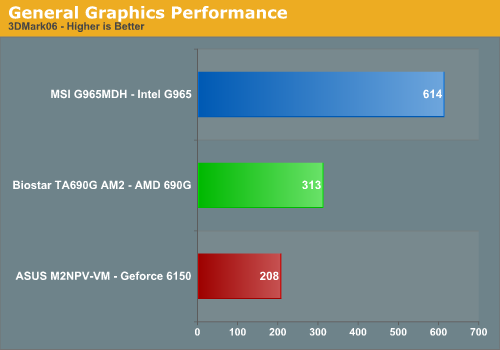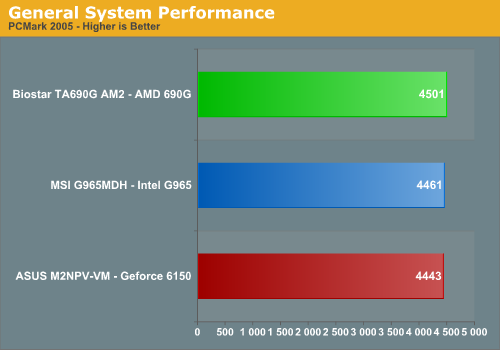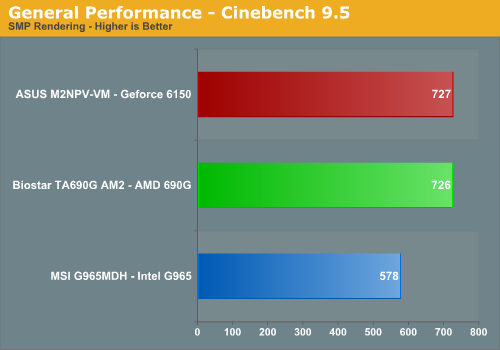Synthetic Graphics Performance
The 3DMark series of benchmarks developed and provided by Futuremark are among the most widely used tools for benchmark reporting and comparisons. Although the benchmarks are very useful for providing apple to apple comparisons across a broad array of GPU and CPU configurations they are not a substitute for actual application and gaming benchmarks. In this sense we consider the 3DMark benchmarks to be purely synthetic in nature but still valuable for providing consistent measurements of performance.

In our first test, the combination of the Intel Core 2 Duo and G965 makes for a great showing against the AM2 offerings. Okay, so we're being a bit sarcastic in that announcement as we consider these results to be anything but great. The Intel platform had no issues running the full 3DMark series but our AMD platforms could not complete the Shader Mark 3.0 tests. However, they exceeded the Intel platform scores in both the SM 2.0 and CPU tests. While the Intel platform passed the SM3.0 tests, this means little in actual game performance where the G965 failed to properly run games with SM3.0 capability.
General System Performance
The PCMark05 benchmark developed and provided by Futuremark was designed for determining overall system performance for the typical home computing user. This tool provides both system and component level benchmarking results utilizing subsets of real world applications or programs. This benchmark is useful for providing comparative results across a broad array of Graphics, CPU, Hard Disk, and Memory configurations along with multithreading results. In this sense we consider the PCMark benchmark to be both synthetic and real world in nature and it provides consistency in our benchmark results.

The margins are closer in the PCMark05 results with the 690G platform showing a minor advantage over the G965 and 6150 platforms. While this benchmark is designed around actual application usage, we will see if these results mirror our application testing.
Rendering Performance
We are using the Cinebench 9.5 benchmark as it tends to heavily stress the CPU subsystem while performing graphics modeling and rendering. Cinebench 9.5 features two different benchmarks with one test utilizing a single core and the second test showcasing the power of multiple cores in rendering the benchmark image. We utilize the standard multiple core benchmark demo and default settings.

The AM2 processors have always enjoyed an advantage in this test and the results continue to show the AM2 platform being dominant in this benchmark with a 26% advantage. The two AM2 platforms basically tie each other indicating CPU throughput is equal on either solution.
The 3DMark series of benchmarks developed and provided by Futuremark are among the most widely used tools for benchmark reporting and comparisons. Although the benchmarks are very useful for providing apple to apple comparisons across a broad array of GPU and CPU configurations they are not a substitute for actual application and gaming benchmarks. In this sense we consider the 3DMark benchmarks to be purely synthetic in nature but still valuable for providing consistent measurements of performance.

In our first test, the combination of the Intel Core 2 Duo and G965 makes for a great showing against the AM2 offerings. Okay, so we're being a bit sarcastic in that announcement as we consider these results to be anything but great. The Intel platform had no issues running the full 3DMark series but our AMD platforms could not complete the Shader Mark 3.0 tests. However, they exceeded the Intel platform scores in both the SM 2.0 and CPU tests. While the Intel platform passed the SM3.0 tests, this means little in actual game performance where the G965 failed to properly run games with SM3.0 capability.
General System Performance
The PCMark05 benchmark developed and provided by Futuremark was designed for determining overall system performance for the typical home computing user. This tool provides both system and component level benchmarking results utilizing subsets of real world applications or programs. This benchmark is useful for providing comparative results across a broad array of Graphics, CPU, Hard Disk, and Memory configurations along with multithreading results. In this sense we consider the PCMark benchmark to be both synthetic and real world in nature and it provides consistency in our benchmark results.

The margins are closer in the PCMark05 results with the 690G platform showing a minor advantage over the G965 and 6150 platforms. While this benchmark is designed around actual application usage, we will see if these results mirror our application testing.
Rendering Performance
We are using the Cinebench 9.5 benchmark as it tends to heavily stress the CPU subsystem while performing graphics modeling and rendering. Cinebench 9.5 features two different benchmarks with one test utilizing a single core and the second test showcasing the power of multiple cores in rendering the benchmark image. We utilize the standard multiple core benchmark demo and default settings.

The AM2 processors have always enjoyed an advantage in this test and the results continue to show the AM2 platform being dominant in this benchmark with a 26% advantage. The two AM2 platforms basically tie each other indicating CPU throughput is equal on either solution.










70 Comments
View All Comments
Gary Key - Wednesday, March 7, 2007 - link
The board will not do 1080P over the HDMI port at this time. 720P is working fine. The mATX will be up on the 19th, provided my heart is still working by that time, have to say that testing under Vista is not a pleasant experience. ;)dmce - Friday, March 9, 2007 - link
Gary, thanks for the info. Is the lack of ability to do 1080p related to Vista or will it just not do it at this stage. Is it likely bios/driver updates will improve this?chucky2 - Thursday, March 8, 2007 - link
Man, to me it sounds like - other than having video and audio in one cable - HDMI is not the way to go.Better to have DVI w/ HDCP it sounds like...plus, the connector is more beefcake, no falling out accidentally with DVI.
Chuck
Gary Key - Tuesday, March 6, 2007 - link
The platform will no do 1080P playback at this time in a consistent matter. As stated, we normally would end up with a slide show or a blank screen. AMD has told us 1080P will be possible with a driver update, proper playback support (PowerDVD or WinDVD), and a processor along the lines of a 5200+. We received a new driver update to address video quality issues we found late in testing but 1080P was not addressed yet. I am just as anxious as everyone else to see if it will do 1080P. ;)savantu - Tuesday, March 6, 2007 - link
This has to be one of the worst review ever done at Anandtech , almost makes you think somebody was paid to do it this bad.we fully believe the majority of the performance difference lies in the chipset selection.
Is this a joke or what ? The 2.6GHz 5200+ against a 1.86GHz Core 2 in media encoding and you think it is the chipset?! Every other test you made put the E6300 in between the 3800+ and 4200+.
goinginstyle - Tuesday, March 6, 2007 - link
Have you ever run a Conroe on a VIA or 945P chipset, if you have then you know what was meant by his statement.JarredWalton - Tuesday, March 6, 2007 - link
Try reading it in context:Nero Recode 2 performance:
AnyDVD Rip = 3-way tie more or less
Shrink = 6150 leads, G965 second, 690G last (despite 6150 and 690G using the same CPU)
Shrink/Burn = G965 first, 6150 and 690G virtually tied.
Full quote, instead of your selected text: "Of course, we are using a mid-range AM2 processor against the budget C2D part (the AMD price cuts have helped matters there, as the price difference is currently only about $35) but we fully believe the majority of the performance difference lies in the chipset selection. It is only in the shrink and burn tests that we see the Intel platform flexing its muscles...."
In other words, the difference we saw in the Shrink test indicates that the 6150 chipset is better for this task than 690G. We definitely know that the Core 2 Duo is faster at equivalent CPU prices than X2 chips, but we're looking at platforms and chipsets and not just CPUs.
UserNO - Tuesday, March 6, 2007 - link
Gawd, people, if you're going to tell us that we'll "have to play at 800x600" if we use these integrated graphics, why not test the games at 800x600 and report framerates? Find the highest (lowest) settings necessary to get a playable experience and tell us that. No one's going to run a game at 1024x768, get 15fps, and then give up; they're going to crank the settings and res down until they can play the game.It's not enough to just say "integrated graphics are unsuitable for even casual gamers, buy a discrete card" and then not quantify the difference.
Gary Key - Tuesday, March 6, 2007 - link
We tested the games at 800x600 and the results will be in our mATX roundup along with dedicated video scores.In the meantime-
800x600- HQ settings
690G 6150 G965
BF2 20.68 17.4 DNF
HL2 35.7 28.8 5.3
CoH 26.4 21.7 24.9
Calin - Wednesday, March 7, 2007 - link
I just wanted to say I'm looking forward to the mATX roundupNice article overall, thanks. And you might want to invest in some cheap Intel and AMD processors (the low-end, for $100 both), just to be able to compare them (I'm not suggesting complete testings on every processor possible)